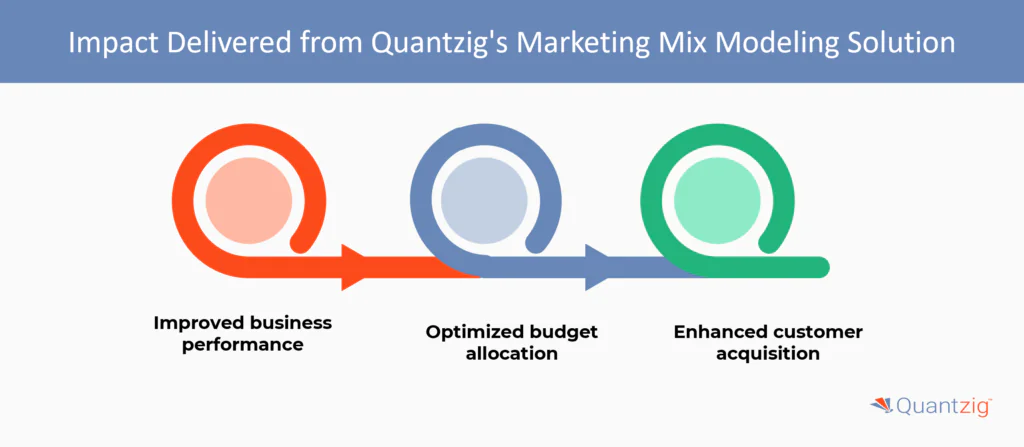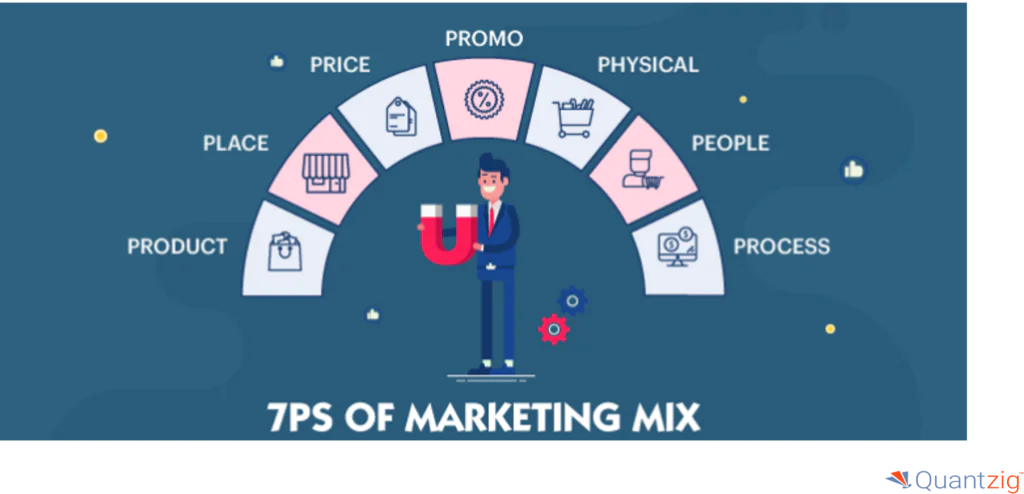Written By: Sudeshna Ghosh
Table of Contents
Introduction to Marketing Mix Modeling for Banks
Despite the current economic uncertainty, leading companies in the banking sector are looking beyond compliance to optimize their businesses and improve financial performance. With the growing need to improve profit margins and drive innovations, leading companies in the banking sector are facing the need for solutions such as bank marketing mix optimization. This industry is leveraging the use of marketing mix optimization to spur profitability and optimize their advertising channels to deal with regulatory and market pressures.
To assess the impact of their marketing activity across different channels, leading companies in the banking sector are approaching renowned solution providers such as Quantzig. With years of expertise in offering a plethora of services, Quantzig’s marketing mix optimization helps banking companies assess the performance of past business initiatives and optimize the future spend to enhance business performance.
Book a demo to experience the meaningful insights we derive from data through our analytical tools and platform capabilities. Schedule a demo today!
Request a Free DemoQuantzig’s Expertise in Marketing Mix Modeling for Banks for a Leading Client in the Banking Sector
| Category | Details |
|---|---|
| Client Details | A leading client in the banking sector. |
| Challenges Faced by The Client | – Allocating future spend to enhance market attractiveness – Aligning with the business planning process to increase sales, profit, and shareholder value – Measuring the impact of advertising on overall sales revenue |
| Solutions Offered by Quantzig | – Bank marketing mix optimization solution – Enhanced brand appeal and target audience reach across multiple media platforms – Gained insights into the return on investment (ROI) for marketing efforts – Accurate tracking of media spend and its impact on sales |
| Impact Delivered | – Improved business performance through strategic optimization of campaigns – Optimized budget allocation for maximum visibility and engagement – Enhanced customer acquisition and competitive position in the banking industry |
Client Details
A leading client in the banking sector.
The Challenges Faced by the Client
A leading client in the banking sector was facing challenges allocating the future spend for enhancing market attractiveness. The client wanted to better align themselves with the business planning process and increase sales, profit, and shareholder value.
Moreover, the client wanted to leverage the use of bank marketing mix optimization solution to measure the impact of advertising on the overall sales revenue. Furthermore, the primary objective of this study was to help the banking sector client optimize their spend on advertising.
The Marketing Mix Modeling Solution Offered by Quantzig
The bank marketing mix solution provided by Quantzig enabled the client to enhance their brand appeal and effectively reach their target audience across multiple media platforms. By implementing this solution, the client gained valuable insights into the return on investment (ROI) for their marketing efforts, allowing for informed decision-making and resource allocation.
Our solution facilitated accurate tracking of media spend and its impact on sales, leading to improved business performance and strategic optimization of campaigns. As a result, the leading bank in the sector was able to optimize its budget allocation, ensuring maximum visibility and engagement with customers across various media channels. This holistic approach empowered the client to drive growth, enhance customer acquisition, and strengthen their competitive position in the banking industry.
Impact Delivered from Quantzig’s Marketing Mix Modeling Solution
– Improved business performance through strategic optimization of campaigns
– Optimized budget allocation for maximum visibility and engagement
– Enhanced customer acquisition and competitive position in the banking industry
Get started with your complimentary trial today and delve into our platform without any obligations. Explore our wide range of customized, consumption driven analytical solutions services built across the analytical maturity levels.
Start your Free Trial todayWhat is the Marketing Mix of Banking Services?
It involves a strategic integration of product offerings, pricing strategies, distribution channels, promotional activities, personnel, operational processes, and tangible elements to deliver exceptional customer experiences and drive business success.
Banks offer a diverse range of products including savings accounts, loans, and investment options, which are priced competitively while ensuring transparency and fairness. These products are delivered through a variety of distribution channels such as bank branches, ATMs, and online platforms, supported by promotional efforts including advertising, direct marketing, and digital initiatives. Through effective management of these components, banks can develop targeted strategies to meet customer needs, comply with regulatory requirements, and stay competitive.
What are the 7 Ps of Marketing in Banking?
In banking, the application of the 7 P’s is crucial for developing and implementing effective strategies to attract and retain customers, navigate regulatory environments, and maintain competitive positioning.
1. Product (Good or Service):
In banking, products refer to the range of financial services offered to customers, including savings accounts, loans, investment products, and insurance. Financial institutions must tailor their product offerings to meet the diverse needs and preferences of customers, ensuring alignment with regulatory restrictions and compliance standards. Intelligent marketing activities are employed to promote these products, highlighting their key attributes and benefits to customers.
2. Price (Product Prices):
Pricing strategies in banking involve determining the cost of financial products and services while remaining competitive in the market. Banks, both public and private sector, need to consider factors such as competitive pricing, customer value perception, and regulatory constraints when setting product prices. Lucrative customers may be offered competitive interest rates or fee structures to attract and retain their business.
3. Place (Bank Branches and Automated Teller Machines):
Place refers to the distribution channels through which banking products and services are delivered to customers. This includes physical bank branches, Automated Teller Machines (ATMs), online banking platforms, and mobile applications. Financial institutions strategically position their bank branches and ATMs to maximize accessibility and convenience for customers, considering factors such as changing customer desires and migrating business trends.
4. Promotion (Promotional Efforts):
Promotion encompasses the marketing activities aimed at creating awareness, generating interest, and driving sales of banking products and services. Banks utilize a mix of promotional efforts including sales promotion, personal selling, and advertising to reach target customers. These efforts are tailored to communicate the value proposition of banking products and differentiate the bank from competitors.
5. People (Bank Employees):
People refer to the personnel involved in delivering financial services, including frontline staff, relationship managers, and support personnel. Bank employees play a critical role in delivering excellent customer service, managing customer relationships, and upholding corporate practices and processes. Training programs and performance incentives are implemented to ensure employees are equipped to meet customer needs and expectations.
6. Process (Processes/Procedures):
Process pertains to the operational procedures and workflows involved in delivering financial services to customers. Banks must streamline processes to speed up transactions, enhance efficiency, and improve the overall customer experience. This involves implementing efficient corporate practices, leveraging information technology (IT) solutions, and adhering to regulatory requirements to ensure compliance.
7. Physical Evidence (Tangible Image):
Physical evidence refers to the tangible elements that contribute to the customer’s perception of the bank’s brand and service quality. This includes the physical appearance of bank branches, the design of online banking platforms, and the ancillary evidence of reliability and security. Banks invest in creating a positive physical image through the design and layout of branches, as well as through the security measures implemented to protect customer assets.
By effectively applying the 7 P’s of marketing, banks can develop comprehensive strategies that address the unique challenges and opportunities within the financial services industry, ultimately enhancing customer satisfaction, driving growth, and maintaining competitive advantage against rivals such as JP Morgan Chase, Wells Fargo, and Citigroup. Additionally, conducting SWOT analysis and Porter’s Five Forces analysis can provide insights into the bank’s internal strengths and weaknesses and external market dynamics, further informing strategic decision-making.
Experience the advantages firsthand by testing a customized complimentary pilot designed to address your specific requirements. Pilot studies are non-committal in nature.
Request a Free PilotWhat are the Potential Challenges in Implementing Marketing Mix Modeling for Banks?
In the banking sector, navigating the marketing mix presents several challenges due to the complex nature of financial services and the dynamic regulatory landscape.
- One challenge involves balancing traditional methods with emerging intelligent marketing activities to effectively engage customers while adhering to regulatory restrictions. Financial institutions must ensure that their strategies align with the fundamental set of attributes associated with trust, reliability, and security, while also leveraging innovative approaches to meet changing customer desires and preferences.
- Another challenge lies in optimizing the promotion mix to reach target audiences through various channels such as sales promotion, and personal selling, while maintaining compliance with regulatory requirements and corporate practices.
- Additionally, banks face the challenge of delivering after-sales support and ancillary evidence to reinforce the tangible image of their brand, especially in the face of increasing competition from both public sector banks and private sector giants like JP Morgan Chase, Wells Fargo, and Citigroup.
Overcoming these challenges requires a strategic approach that integrates traditional and digital marketing tactics, prioritizes customer relationships, and demonstrates a commitment to delivering exceptional financial services while navigating regulatory complexities and market dynamics.
How Do Banking Sectors Use Marketing Mix Modeling?
- Large, international consumer packaged goods companies were the first to use marketing mix modeling in the early 1990s. Using this method, the historical correlation between marketing expenditure and company performance was examined.
- Marketing Mix Modeling Software as a Service (SaaS) is used by organizations to assess the efficacy of various marketing components, including price breaks, trade shows, digital, print, and television advertising. With this kind of information, businesses can make marketing decisions more quickly and based on data.
- Platforms for marketing mix modeling were first available only to Tier 1 brands and businesses with substantial marketing budgets. Small and medium-sized businesses did not use marketing mix modeling because of low awareness and false beliefs that it required too much time and effort. Nevertheless, given the current circumstances, businesses of all sizes are beginning to use marketing mix modeling. In marketing-heavy industries like retail, pharmaceuticals, financial services, telecom, automotive, travel, and hospitality, the DIY Marketing Mix Modeling solutions are particularly helpful.
- For Tier 2 or Tier 3 businesses, the more recent Marketing Mix Modeling platforms are significantly more economical, easier to use, and quicker to deploy. Additionally, Marketing Mix Modeling has become “Always-On” due to its advancements. They can provide real-time, more actionable insights and measure the efficacy of marketing continuously.
- With the newest MMM DIY solutions, businesses can access an easy-to-use interface, assess recent marketing campaigns, quickly update models with the most recent data, and produce real-time insights whenever needed to maximize Return on Marketing Investment at reasonable prices and optimize marketing expenditures while on the go.
- Today’s banking sectors are significantly enhancing the delivery of marketing mix modeling by utilizing automation and technology. More Tier 2 and Tier 3 businesses will be encouraged to use Marketing Mix Modeling platforms due to increased knowledge and instruction regarding the potential of marketing analytics.
Conclusion
Marketing Mix Modeling for banks is a vital component of an effective Marketing Strategy. By analyzing the 7Ps—Product, Price, Place, Promotion, Customer Service Interactions, Marketing and Promotional Materials, and Financial Services—banks can optimize their media mix including TV advertising, print advertising, digital marketing, and trade promotions. Utilizing Marketing Attribution and regression analysis within the modeling process, banks can better understand KPIs (Key Performance Indicators), pricing, and purchasing power. This comprehensive approach empowers banks to strategically allocate resources, enhancing their Marketing Mix and driving improved business performance through Media Mix Modeling.







